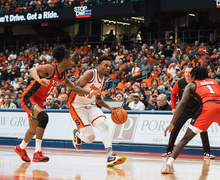Managing queer relationships, friendships (and where they intersect)
Flynn Ledoux | Contributing Illustrator
“Friendcest” may cause conflict, but it's one of the only ways the queer community at SU can connect with other people they relate to. Our columnist proposes other (maybe less drama-inducing) ways to find community.
Get the latest Syracuse news delivered right to your inbox.
Subscribe to our newsletter here.
“Friendcest” may not be a familiar word for everyone, but it’s been commonly used to describe when people date or get together within their friend groups. While “friendcest” is something that many young adults have experienced, it seems that it occurs a lot more in queer spaces.
One reason I have found that makes dating within the friend group so common in queer spaces is because, for a lot of queer people, that’s the only option.
At my high school in suburban Ohio, my friend group consisted of almost all of the openly queer people in my grade. So when I began to look for a relationship, my options for other queer women were limited to this group since those were the only queer women I knew.
Even after the relationships ended, I continued being friends with all of them in high school. The reason? They were the only queer friends I had.
Having friends who shared this common identity with me was important because it allowed me to discuss things that I couldn’t always talk about with my straight friends. For example, when I accidentally came out to my parents, my close friend who had already come out to her mom was the one I went to help me through the aftermath.
It’s been awkward, to say the least, to play games of Jackbox or Cards Against Humanity with two of my exes and our mutual friends, but I pushed through the awkwardness so I could stay with them. I wouldn’t risk friendships and connections like that over one failed relationship.
While there is definitely a larger LGBTQ+ community here at Syracuse University, “friendcest” is still widespread.
In my experience, I typically see one of two things happen in terms of “friendcest.” The first option is meeting someone through the friend group and developing a long-term relationship with them, which is actually how I met my girlfriend.
The other and more common option, however, is hooking up with someone, or sometimes multiple people, in the friend group. And in my experience, drama is often the main result.
I am certainly in no position to advise against exploring relationships within your friend group, however, there is always the risk of fracturing friendships. That is why I recommend trying to meet people outside your circle of friends.
There are dating apps that are designed for queer people, such as HER. The queer clubs and centers on campus are also great ways to meet people within the community outside of people you already know.
If you’re looking to expand your queer community, the LGBTQ+ Resource Center within the Schine Student Center is a great place for meeting more people. Whether going for “Knit 3 Spill the Tea” or just going for a nice lunch spot, there are always people there to get to know.
Throughout my time at SU, I have also been able to connect with other queer students outside of designated queer spaces. Just the other night I went to a creative writing group meeting (which is arguably an LGBTQ+ space) where I met four other queer students. Not only was I able to talk about queer topics with these new friends, but I was able to talk about our shared interest in writing as well.
While I found romantic success within the friend group, many of my friends have made great connections while just going out on campus. In the end, the choice of who you explore relationships with is up to you, and sometimes the feelings you have for another person outweighs the risks that might come with it.
College is a time to explore, so meet new people, make new connections and find community in your own unique way. Even if your connection with someone doesn’t work out as intended, the queer community is a strong one, and that’s what’s important.
Claire McBride is a freshman Magazine, News and Digital Journalism major. Her column appears bi-weekly. She can be reached at Cpmcbrid@syr.edu.
Published on January 30, 2024 at 11:17 pm






